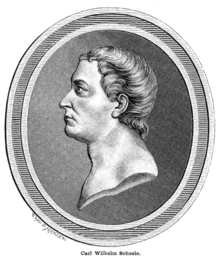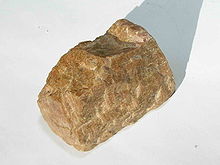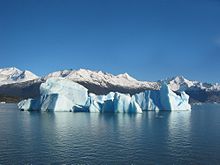Oxygen
![]()
Oxygenium is a redirect to this article. For the geological period of the same name, see Oxygenium (period).
Oxygen (also called oxygenium; from ancient Greek ὀξύς 'oxys' "sharp, pointed, acidic" and γεννάω 'gen-' "to produce, give birth to", together "acid-producer") is a chemical element with the element symbol O. According to its atomic number 8, it is placed eighth in the periodic table, where it is in the sixth main group, or 16th IUPAC group, along with the elements sulfur, selenium, tellurium, polonium, and livermorium, which make up the chalcogens. In terms of mass, oxygen is the most abundant element in the Earth's crust (48.9%), the most abundant element in the Earth's envelope, and the second most abundant element in the Earth as a whole (iron is in 1st place), at about 30%.
Under normal conditions, oxygen occurs in the form of a covalent homodimer, i.e. a compound of two oxygen atoms and with the molecular formula O2, referred to as molecular oxygen, dioxygen or disoxygen. It is a colorless and odorless gas that is present in 20.942% of air. It is involved in many combustion and corrosion processes. Almost all living things need oxygen to live (but plants usually give off more oxygen than they consume during photosynthesis). They take it mostly by respiration from the air or by absorption from water (dissolved oxygen). In high concentrations, however, it is toxic to most living organisms.
The metastable, energetic and reactive allotropic form consisting of three oxygen atoms (O3) is called ozone.
Atomic oxygen, i.e. oxygen in the form of free, individual oxygen atoms, occurs stably only under extreme conditions, for example in the vacuum of space or in hot stellar atmospheres. However, it has an essential importance as a reactive intermediate product in many reactions of atmospheric chemistry.
History
In the 18th century, Carl Wilhelm Scheele (between 1771 and 1773, published in 1777) in Sweden and Joseph Priestley in England (1771, publicly described in 1774) independently discovered oxygen in connection with the study of combustion processes. Pierre Bayen also came very close to the discovery in 1774.
From the Stone Age until beyond the Middle Ages, fire was a phenomenon for man that was accepted as a gift from heaven. Various ideas about the nature of fire were developed by the natural philosophers of antiquity up to the alchemists. Fire was understood as a basic substance of the four elements doctrine. In the 17th century, the notion of a "light mysterious substance" emerged. This phlogiston would escape from the burning substance, heat was understood as a substance. The German-Swedish pharmacist Carl Wilhelm Scheele carried out experiments. When heating manganese dioxide or potassium permanganate with concentrated sulfuric acid (vitriol), he obtained a colorless gas. This gas promoted combustion and Scheele called it "fire air" or "vitriol air" after its origin. He found that air consisted of this oxygen and "foul air." Quite independently, the Englishman Joseph Priestley was able to produce oxygen gas two years later by heating mercury oxide. The Briton published his findings in 1774, but Scheele did not publish his book Chemische Abhandlung von der Luft und dem Feuer until 1777.
With the discovery of oxygen, its importance in combustion had not yet been clarified. The Frenchman Antoine Lavoisier found in his experiments that phlogiston does not escape during combustion, but that oxygen is bound. By weighing, he proved that a substance was not lighter but heavier after combustion. The cause was the additional weight of the oxygen absorbed during the combustion process. Initially, oxygen was assumed to be the basic ingredient for the formation of acids. Therefore, the name oxygenium (acid-forming agent) was proposed for oxygen by Lavoisier in 1779. In fact, most inorganic acids contain oxygen when nonmetal oxides are dissolved in water. The halogens, such as chlorine and bromine, were therefore long thought to be oxides of unknown elements. Only later was it recognized that hydrogen was responsible for the acid character (Humphry Davy, from 1808). In 1883, Karol Olszewski and Zygmunt Wróblewski succeeded in producing liquid oxygen for the first time.

Carl Wilhelm Scheele, one of the discoverers of oxygen
Occurrence
Occurrence on earth
Oxygen is the most common and widespread element on Earth. It occurs in the Earth's atmosphere as well as in the lithosphere, the hydrosphere and the biosphere. Oxygen has a mass fraction of 50.5% in the Earth's atmosphere (up to a depth of 16 km, including the hydrosphere and atmosphere). Its mass fraction in air is 23.16 % (volume fraction: 20.95 %), in water 88.8 % (in seawater, however, only 86 %, since larger quantities of non-oxygenated salts, e.g. sodium chloride, are dissolved there).
Oxygen mostly occurs in its compounds on and in the earth. In the earth's shell, besides water, almost all minerals and thus rocks contain oxygen. The most important oxygen-containing minerals include silicates such as feldspars, mica and olivines, carbonates such as the calcium carbonate in limestone, and oxides such as silicon dioxide as quartz.
In its elemental state, oxygen is found in the form of O2 in gaseous form in the atmosphere and dissolved in water. The amount of relatively reactive elemental oxygen only remains constant in the long term because oxygen-producing plants supply as much as is consumed again by aerobically breathing organisms and by other combustion processes. Without this biological cycle, oxygen would only occur in compounds; elemental oxygen thus exists in a steady state. The evolution of oxygen concentration in the Earth's atmosphere is described in the article Evolution of the Earth's Atmosphere. The oxygen allotrope O3 ozone is present in the atmosphere only in low concentrations.
Occurrence in space
In the universe, oxygen is the third most abundant element after hydrogen and helium. The mass fraction of oxygen in the solar system is about 0.8 % (this corresponds to an (atomic) number fraction of about 500 ppm).
Oxygen is not formed in primordial nucleosynthesis, but is formed in relatively large quantities in giant stars by helium burning. In this process, 12C is first formed from three helium nuclei (three-alpha process), which then fuses with another helium nucleus to form 16O. 18O is formed by fusion of a 4He with a 14N nucleus. Oxygen also plays a role in energy production in so-called main sequence stars such as the Sun. In the CNO cycle (Bethe-Weizsäcker cycle), oxygen is an intermediate product of the nuclear reaction in which a 4He nucleus (alpha particle) is formed by proton capture of a 12C nucleus acting as a catalyst. In extremely heavy stars, oxygen burning occurs in the late phase of their evolution, in which the oxygen serves as nuclear fuel for reactions that lead to the construction of even heavier nuclei.
Most white dwarfs, which according to theory represent the final state of 97% of all stars, consist to a large extent of oxygen in addition to helium and carbon.

Feldspar

Water
Questions and Answers
Q: What is the symbol for oxygen?
A: The symbol for oxygen is O.
Q: How many atoms of oxygen are usually found in dioxygen (O2)?
A: Dioxygen (O2) typically contains two atoms of oxygen.
Q: What color is liquid or solid oxygen?
A: Liquid or solid oxygen is pale blue in color.
Q: What group on the periodic table does oxygen belong to?
A: Oxygen belongs to the chalcogen group on the periodic table.
Q: How much of Earth's atmosphere by volume is made up of oxygen?
A: Oxygen makes up more than a fifth of Earth's atmosphere by volume.
Q: How do plants and other organisms produce most of the Earth's atmospheric oxygen?
A: Plants and other organisms produce most of the Earth's atmospheric oxygen through photosynthesis, which involves using sunlight to convert water into hydrogen and releasing oxygen as a byproduct.
Q: What uses does liquid or solidified form ofoxygen have?
A: Liquid or solidified forms ofoxygen can be used as rocket propellants, for welding, medical purposes, and breathing when there is no good air available (e.g., divers and firefighters).
Search within the encyclopedia